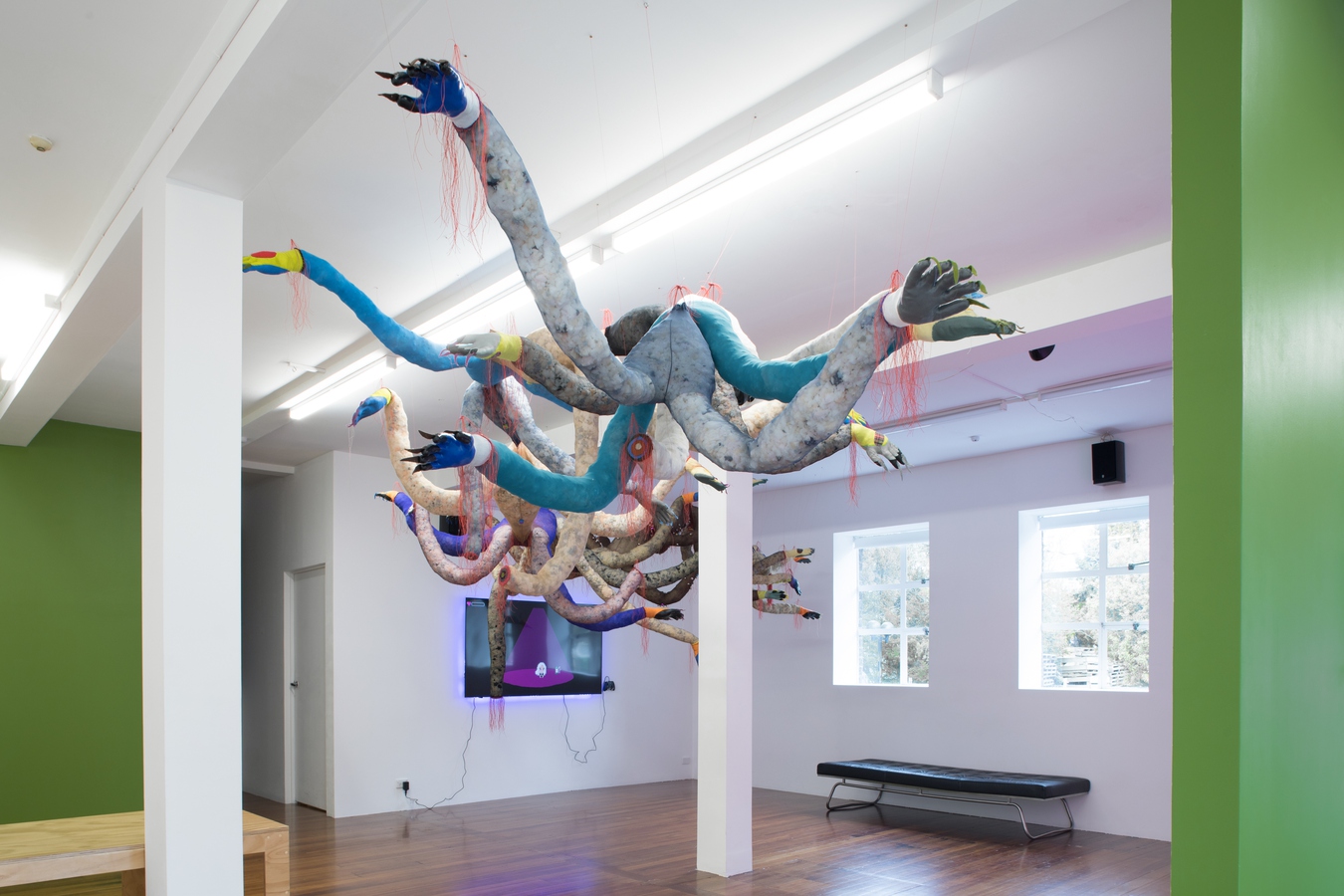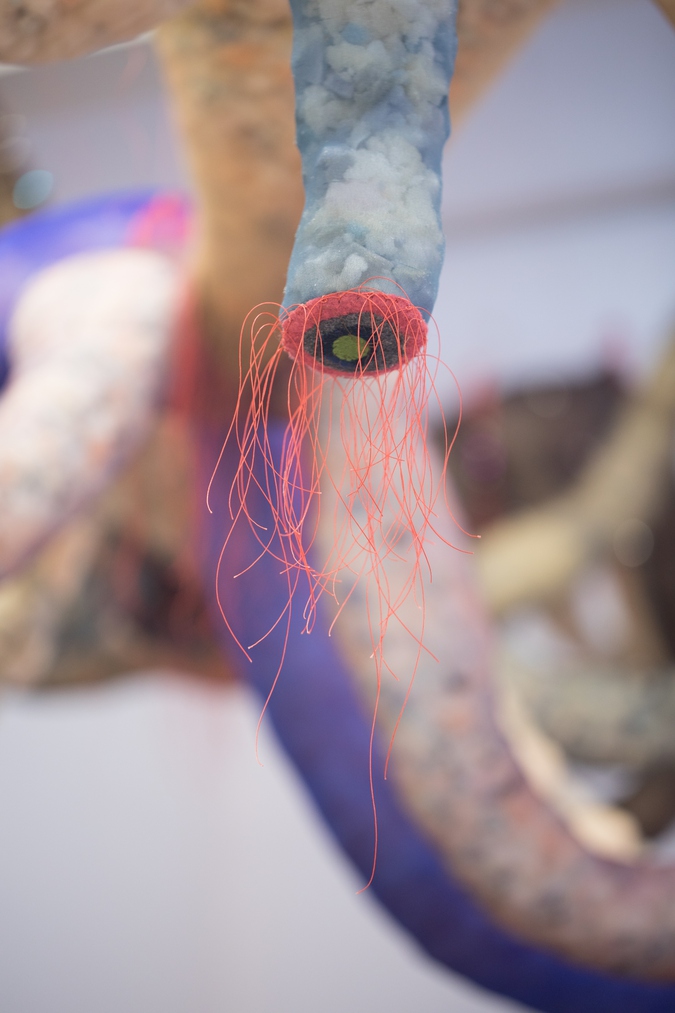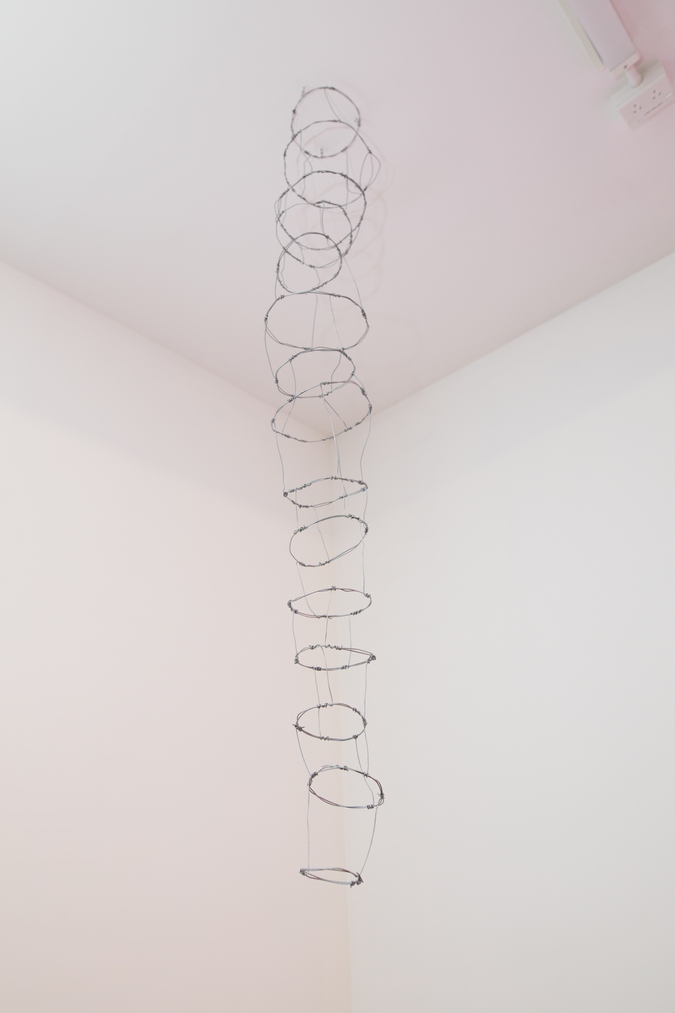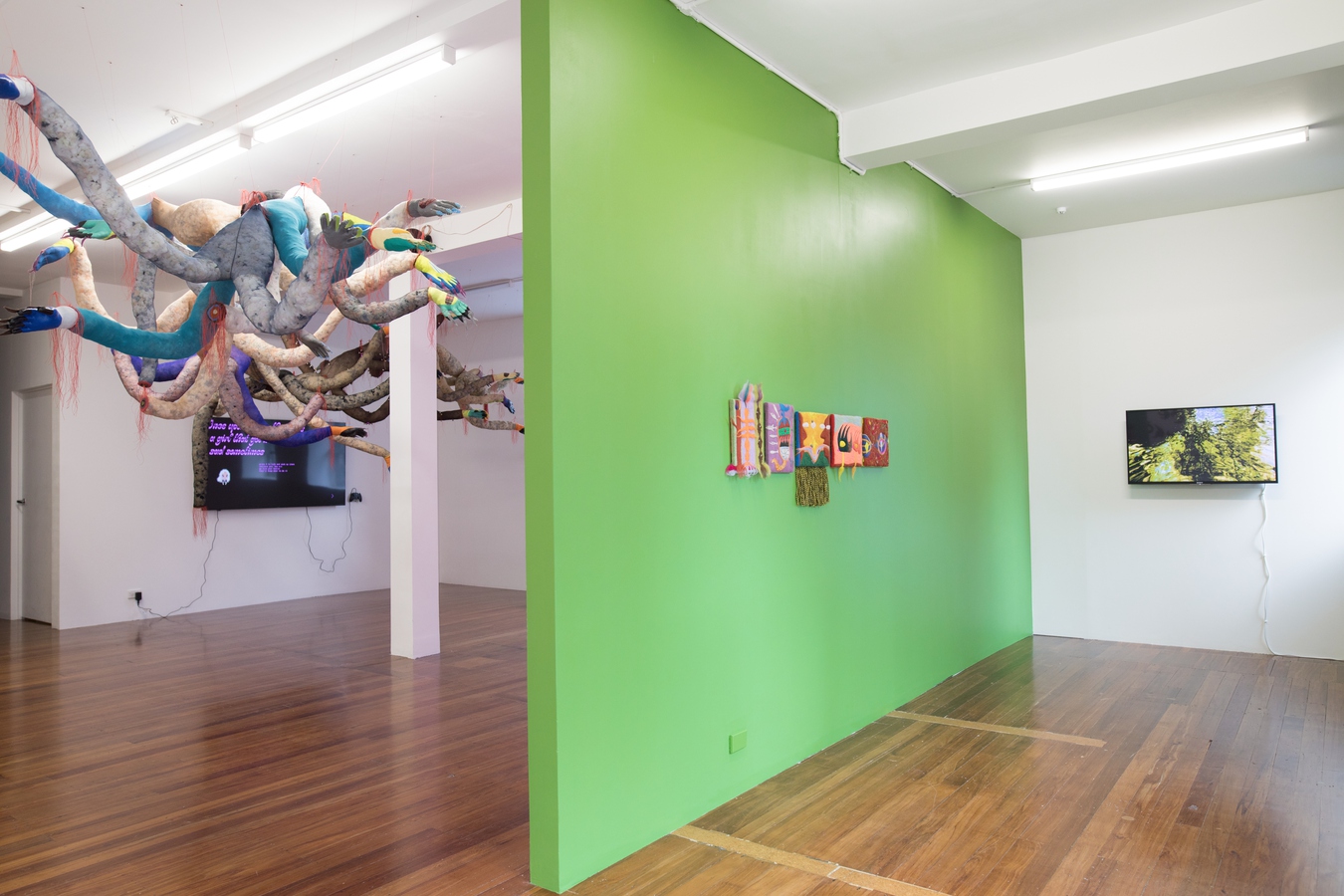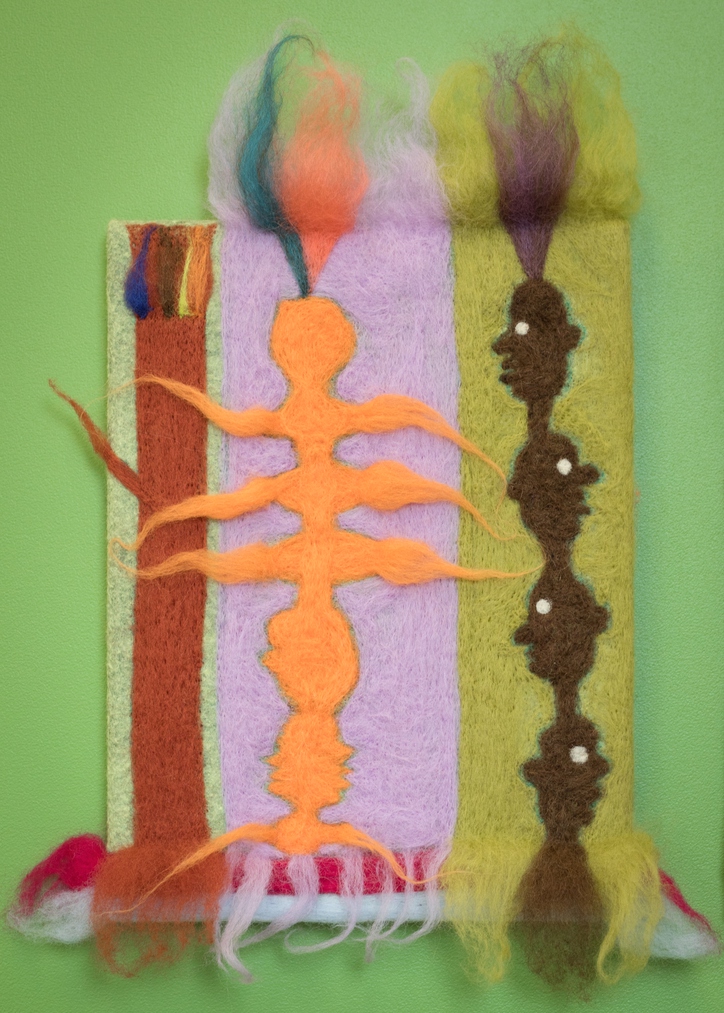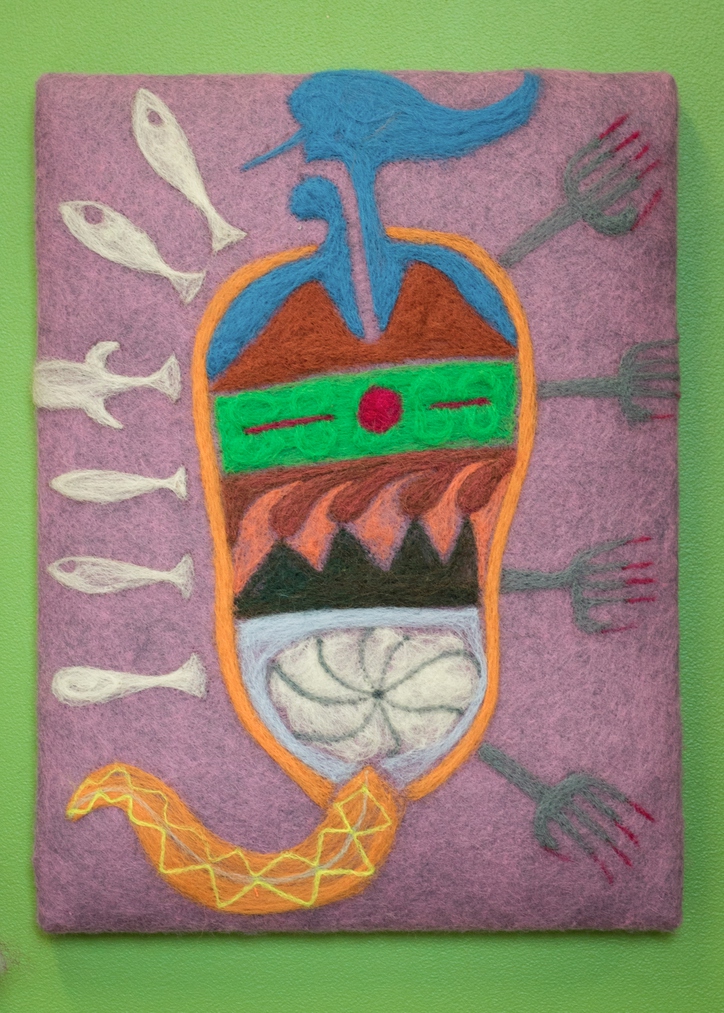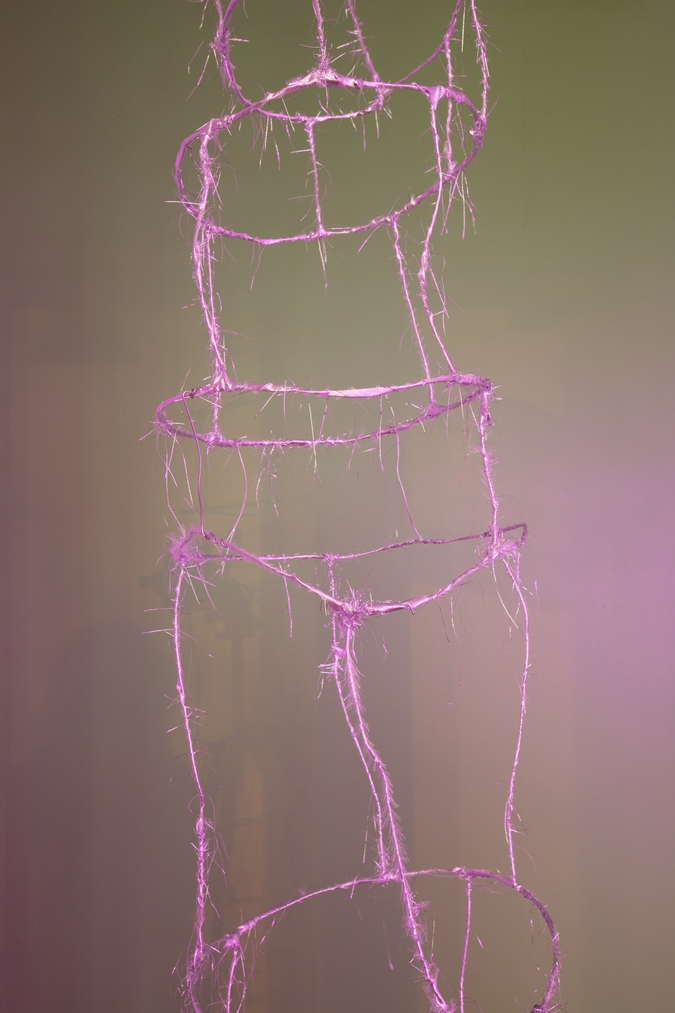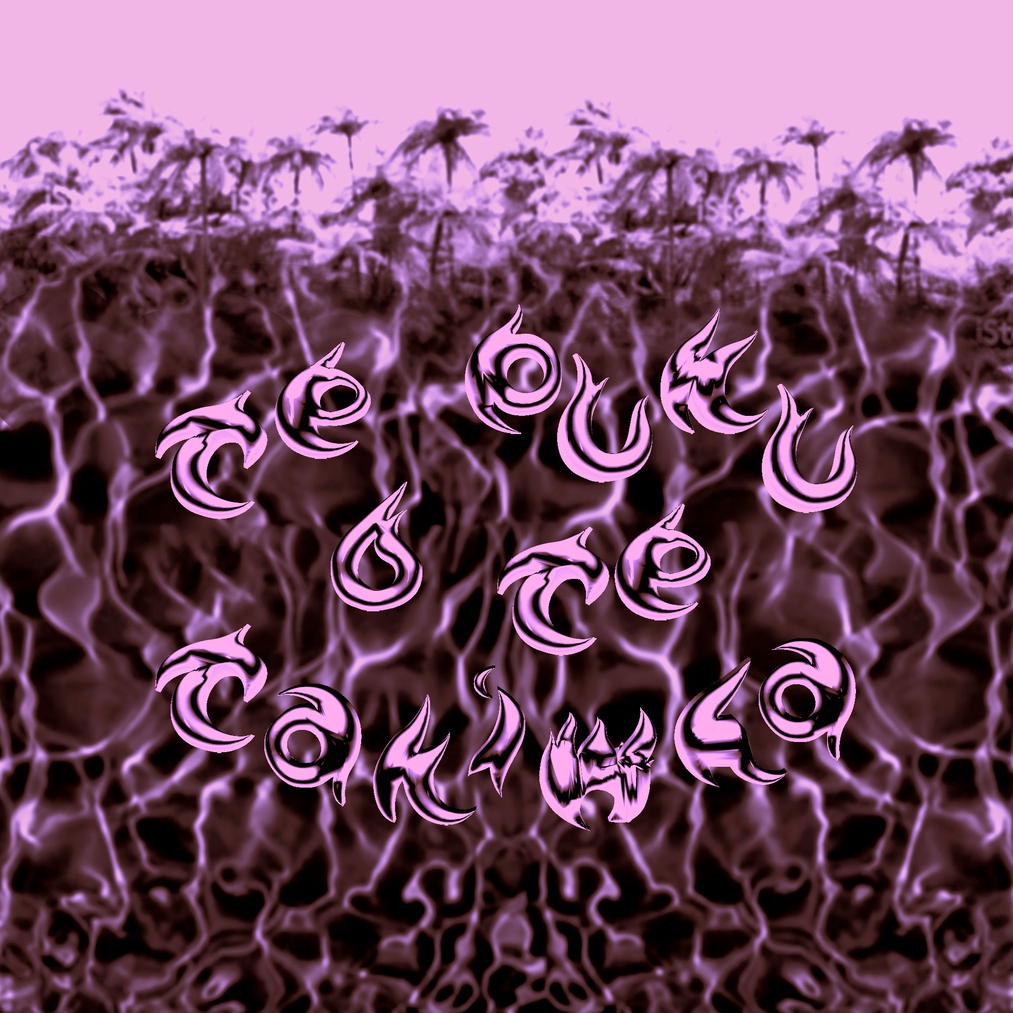Aj Fata, Kahurangiariki Smith and Tyrone Te Waa
Te puku o te taniwha
04 Aug — 03 Sep 2023
Te puku o te taniwha
Aj Fata, Kahurangiariki Smith and Tyrone Te Waa
Curated by Aj Fata
Exhibition runs: 4 August – 3 September 2023
Whakatau and opening: Friday 4 August, from 5:30pm
What does a taniwha feed on? What does a taniwha listen to down the Waikato awa? What dance moves does a taniwha have? And what if that taniwha swallowed The Physics Room?
These are some of the pātai underpinning this exhibition, initiated by Aj Fata, whose work sits alongside that of Kahurangiariki Smith and Tyrone Te Waa. The three artists inhabit the gallery as a space of transformation: where states can shift, collective energy and intimacy can build, and difficulty can be processed. “The puku, where sinking intuition creeps from the inside out. An embodiment of our conscience. It is a place of constant movement and sound. A dance between mauri and waste”, writes Fata. Influenced by club culture, dance music and other forms of popular media, and grounded in mātauranga Māori, Fata, Smith and Te Waa’s practices propose a present and future where shapeshifting and fluidity of identities are an expected and accepted part of life, and where the puku is at the centre of our being, physically, spiritually, and psychologically.
This puku is a place of motion. The exhibition includes a video game and LED light work (Kahurangiariki Smith), a moving image work, an audio track and wire sculpture (Aj Fata), and the many-limbed tinana of Tyrone Te Waa’s Fleapit, who meets you at the threshold and arcs through the gallery. Watching over the space, moving through it like a backbone, Fleapit was initially made for a club night at Basement Theatre in Tāmaki Makaurau. For this project Fleapit has grown longer, and is suspended in the air so that as you walk through the gallery you move between limbs, some of which prop or lean themselves against the architecture of the room.
Fata’s Wairepo is a grounding work for the project. The video tells a story of whakawhanaungatanga between Fata and whenua. The work brings the whenua into the space through a fast-paced stream of images which acknowledge the presence and vitality of the wetlands and awa. Wairepo is located to the right as you enter the gallery, beside a window which opens onto the carpark outside; a point of meeting and ongoing interaction with the swampy whenua of Ōtautahi, and the awa Ōtākaro. Five felted works by Te Waa, also in the gallery’s green-walled first space, suggest different modes of taniwha-being: Taniwha Guru, Healing waters for our Sissy Taupiri, Swamp Hen. Kānga Pirau, referring to fermented corn porridge, completes the series.
Smith’s work, What if my best friend was a taniwha?, a video game developed and coded by the artist, is a quest for hauora or wellness. The game is one outcome of the artist’s regular walks along the Waikato awa where she lives, and offers different ways to think about what contributes to being well: rongoā, soju, friendship, and the awa itself. You are invited to play the game, collecting tokens (soju, kawakawa, wai) to increase your hauora. Facing the video game, on the opposite side of the room is Hina, a pink-glowing LED work, a mata or face. Smith has written (of an earlier iteration of this work),
Hina is [a] constant throughout time and across oceans. Hina has known many names: Hina, Ina, Sina, Hine. As Hine, she is known as the female element embodying mana wāhine.1 As Hina-i-faʻauru-vaʻa she is the OG navigator, daring to travel beyond the moana to the skies and become Hina-aa-i-te-marama.2 Hina, also called Hinauri, is one of the many names for the moon3—she’s watched over us mai rā anō. Hina—the constant, the ever changing, who pushes and pulls the moana, who ripples across the water on a dark night. No doubt our tūpuna looked up at her in those quiet moments, as the waves licked at the waka, and she looked back. He mihi aroha tēnei ki a ia.
Fata’s audio work intermittently fills the space like water, moving through different phases of energy. An invitation to shift your focus from looking, reading, understanding things in external ways, this is a koha to the body and other senses. Stand, sit, or lie still in the space and you can feel the sound in your body: a form of listening with more than your ears. Completing the space, Hinaki Taniwha Hikuroa, sparkling in silver threads and raw grey wire, is suspended in both corners—or perhaps it snakes through the ceiling by the library, to reappear at Hina’s side. Based on the form of the hīnaki or eel trap, this sculpture could also reference a portal, a chrysalis, or an oesophagus. These are structures that enable change—digestion, morphing, resting—in anticipation of powerful re-emergence. As a whole the show recognises the deep connection between the puku and the heart, as held in the whakataukī, Ahea, kua kī te puku, kua kī te ngakau hoki.
1 Aroha Yates-Smith, Hine! E Hine!: Rediscovering the feminine in Maori spirituality (Kirikiriroa: University of Waikato, 1998).
2 Nālani Wilson-Hokowhitu, Ka Makana (Kirikiriroa: Hālāwai Publishing, 2019).
3 Aroha Yates-Smith, ibid.
--
Aj Fata (Ngāti Makirangi / Sāmoa) grew up in South Auckland, Manurewa. Spanning a range of media including digital, print-making, poetry and music, the backbone of her practice is indigenous empowerment in te ao hurihuri. Fata’s work was part of The water tastes different here, Tautai Gallery, Tāmaki Makaurau, 2022, within the rōpū In*ter*is*land Collective, a tagata Moana, queer-led collective based in London and Aotearoa and the expanse of moana between. Fata is currently undertaking rūmaki reo Māori study through Te Wananga Takiura o Ngā Kura Kaupapa Māori o Aotearoa, and exploring electronic music through the alias ajhoneysuckle.
Kahurangiariki Smith’s waka are Te Arawa, Tainui, Takitimu, Horouta and Mataatua. She is based in Kirikiriroa. Smith’s practice frequently focuses on mana wāhine, and is influenced by ideas of indigenous futurism. Sometimes playful, sometimes cheeky, Kahurangiariki’s work explores a range of media such as moving image, karaoke, video games, and neon. Smith was part of the group exhibition Māori Moving Image ki Te Puna o Waiwhetū, Ōtautahi, 2022. She has made work in collaboration with her mother, Aroha Yates-Smith, and worked alongside Graeme Atkins, Alex Monteith and Natalie Robertson on ‘Te rerenga pōuri o nga parawhenua ki Te Moana-nui-ā-Kiwa’, Moana Don’t Cry, Te Tuhi, Pakuranga, 2019. Most recently, Smith’s work was included in the 15th Sharjah Biennale, Thinking Historically in the Present, Sharjah, United Arab Emirates, 2023.
Tyrone Te Waa (Ngāti Tūwharetoa) lives and works in Tāmaki Makaurau. Te Waa typically works with materials, making sculpture and more recently, wall based textile work which continue to be informed by his research into takatāpui, queer, and gay histories. He completed a Master of Creative Practice through Unitec in 2021, and has since held exhibitions including Clingwrap, Sanc Gallery, and A New Net: Four Early-Career Māori Artists at Tim Melville Gallery, both in Tāmaki Makaurau, 2021. Te Waa’s solo exhibition, WīWī WāWā, is on at Anna Miles Gallery, Tāmaki Makaurau, until 12 August 2023.


